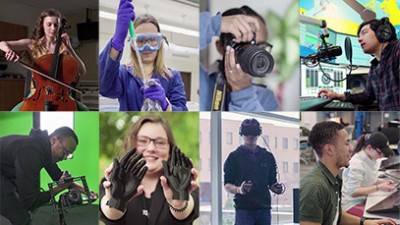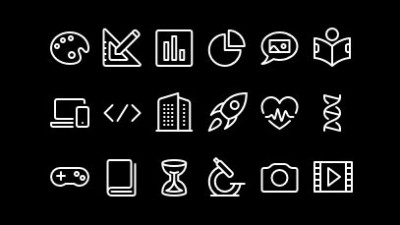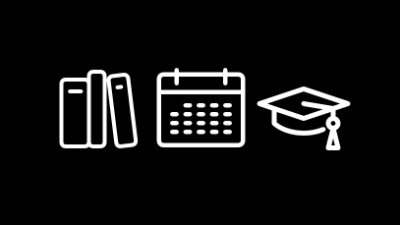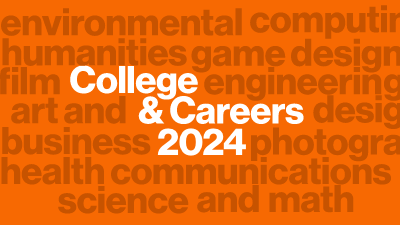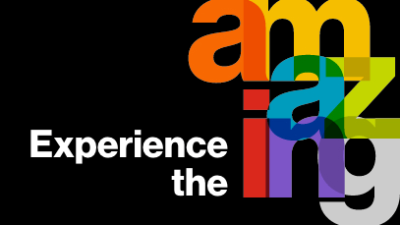Photography Minor - Curriculum
Photography Minor
| Course | |
|---|---|
| Required Courses | |
| PHAR-161 | Intermediate Digital Photography for Non-Majors This is the first required course for students enrolled in the photography minor. This course will reinforce and build upon the skills learned in Introduction to Digital Photography. It will emphasize aesthetics, craft, visual problem solving, skill development, and critical thinking skills. In this course, students will work in the studio and be introduced to the skills needed to use, create, and control artificial lighting as well as develop skills for modifying found light on location. Students will also make photographic prints. The curriculum will emphasize both craft and visual problem-solving skills necessary to achieve industry standards and prepare students for other courses available in the minor. Fee required for non-majors. (PHAR-160 or equivalent course.) Lab 2, Lecture 2 (Fall, Spring). |
| Choose one of the following: | |
| PHAR-201 | Elements of Fine Art Photography This course will offer students an introduction to the discipline of fine art photography. Conceptually driven projects will be investigated through a variety of photographic techniques; reading, writing and discussion about the intent and meaning of photographic imagery will be emphasized. Aspects of still photography and moving imagery as artistic choices and practices will be presented. The goal of the course is to establish theoretical, aesthetic and technical strategies for the production of photographic artwork. If you are pursing the Fine Art Photography option this course is required. (Prerequisites: PHPS-102 or PHAR-102 or PHAR-161 or equivalent course.) Lab 3, Lecture 2 (Fall, Spring, Summer). |
| PHAR-202 | Elements of Advertising Photography This course will introduce students to the field of assignment photography. Students will create images from assignments that relate to projects they could encounter after graduation. They will be instructed in the basic photographic skills needed in the photography industry. Practical use of exposure metering and digital workflow will be discussed. Training will be provided in the use of professional cameras and lighting equipment, as well as developing marketing materials. Portraiture and still life photography will be covered both in the studio and on location. Students will learn about career choices available in the photography industry as well as encourage students to develop their own artistic vision. (Prerequisites: PHPS-102 or PHAR-102 or PHAR-161 or equivalent course.) Lab 3, Lecture 2 (Fa/sp/su). |
| PHAR-203 | Elements of Photojournalism This course will serve as an introduction to visual story telling as it relates to professional photojournalism. It will provide relevant practice in basic technical, compositional, and interpersonal skills necessary in all aspects of modern photography. Students will be exposed to photojournalism - documentary, editorial, narrative, and editing - as well as explorations of current career possibilities. Lectures, critiques, demonstrations, and assignments will provide participants the opportunity to explore the still, audio, and multimedia strategies used for storytelling. In this course students are expected to meet real-world project deadlines and participate in class discussions and critiques. (Prerequisites: PHAR-102 or PHAR-161 or PHPS-102 or equivalent course or students in the JOURNAL-BS program.) Lab 3, Lecture 2 (Fall, Spring). |
| PHAR-204 | Elements of Visual Media This course will provide an introduction to the professional opportunities where the fields of photography, graphic design and print media overlap. Students will develop an understanding of the working relationships between professionals involved in each of the three career areas. Successful visual media experts require a contemporary understanding of the business practices necessary to manage the workflow, financial operations and personnel necessary for success. Students in this class will experience the breadth of interactions between these three career paths, and appreciate the management necessary in their dynamic relationships. Students pursing the Visual Media option are required to take this course. (Prerequisites: PHPS-102 or PHAR-102 or PHAR-161 or equivalent course.) Lecture 3 (Fall, Spring, Summer). |
| PHPS-201 | Scientific Photography I The first course of a two-semester sequence that will develop photographic skills and approaches required in scientific photography. The course will develop scientific methods required for standardized imaging. Appropriate subjects including contact lenses, rice grains and other challenging, nearly invisible objects will be explored. Students will investigate unique illumination techniques in order to reveal a subject’s unusual characteristics. Techniques including polarized light and fluorescence reveal what cannot easily be observed without specialized photographic imaging and image processing. In addition, the course will expose students to ethical problems encountered in scientific imaging including managing and processing digital data. (Prerequisites: PHPS-102 or PHAR-102 or PHAR-161 or equivalent course.) Lab 3, Lecture 2 (Fall). |
| Upper Division Electives | |
| IDEA-315 | Outside the Box Outside the Box is an experimental class where students explore analog photography’s inherent qualities as an aesthetic and conceptual investigation without the need of prior photographic experience. The course will examine a variety of techniques and historical processes that may include experimental studio lighting, using projections as light sources, cyanotypes, remote portraits using video conferencing software, and image transfers as well as traditional black and white darkroom printing.
In an environment where everyone is free to experiment with photography, this course challenges the notion of what a photograph can encompass. Students are encouraged to embrace failure as an important part of the creative discovery and learn how failure shows us a new view of success. This class will become a community where we share our experiments and build on each other’s trials in order to push the boundaries of what is possible and see what we can discover. A materials fee is required for this course, and an additional course fee applied via student account. Studio 5 (Fall or Spring). |
| IMSM-301 | Imaging Systems This course will explore the technological fundamentals used in imaging systems. The course emphasizes the operation of devices/components used to optimize imaging systems. Fundamental concepts prevalent in imaging systems such as resolution, dynamic range, sensor architectures, printer and monitor technologies, color spaces, and image optimization workflows will be presented. Focus will be on the proper selection and underlying principles of these technologies and how to best apply that knowledge to solve problems in the imaging industry. Potential careers in the imaging industry will be presented throughout the course. (Prerequisite: PHPS-107 or SOFA-103 or equivalent course.) Lecture 3 (Fall). |
| IMSM-302 | Color Management Technology This course, primarily designed for photographers, will provide students with hands on experience using software and hardware fundamental to contemporary practices in the imaging industry. It has been designed to expose students to a managed color workflow beginning at capture and culminating in output. The course will explore standard color instruments and give the essential knowledge and skills required to solve problems prevalent in the photographic field. Critical problem solving of accurate color reproduction across media will be investigated. (Prerequisites: IMSM-301 or equivalent course.) Lab 3, Lecture 2 (Spring). |
| PHAR-363 | Black and White Photography I This course, the first part of a two-semester sequence, will introduce students to the exposure and development of black and white film and the procedures for making high quality black and white photographic prints in a traditional darkroom with chemicals, safe lights and enlargers. Included in this course are 35mm, medium and large-format cameras, variables in making fine black and white prints and techniques for archival and museum quality processes and methods of display. Students must have access to a film camera with adjustable exposure controls. Each student will produce a finished portfolio of black and white fine prints. (Prerequisites: PHAR-101 or PHAR-160 or equivalent course.) Lab 4, Lecture 2 (Fall or Spring). |
| PHAR-364 | Black and White Photography II This course, the second course of a two-semester sequence, will introduce students to the use and manipulation of specialty analog cameras (e.g., pinhole, Holga, Hasselblad fish-eye, X-Pan, view camera), as well as methods of making “monoprints” - one of a kind photographs using analog processes such as photogram, chemogram, hand-coloring, and negative alteration. Students will also work collaboratively to expose and process large-format prints. Selections of work by noted photographic artists and others enrolled in the course will be analyzed and interpreted by students in both critiques and written assignments. A creative portfolio of black and white prints and/or monoprints will be produced by each student. (Prerequisites: PHAR-150 or PHAR-363 or equivalent course.) Lab 4, Lecture 2 (Spring). |
| PHAP-301 | Advertising Photography I This is the first of a sequence of required advertising photography courses that investigates visual problem solving when applied to commercial photography. Studio and other controlled environments will be encountered through assignments. Advertising and editorial solutions and applications will be explored. The skills necessary to photograph people, places, and things will be learned through various assignments. (Prerequisites: PHAR-202 or equivalent course.) Lab 3, Lecture 2 (Fall). |
| PHAP-311 | Photographing People An advanced study of people photography, this course will focus on the development of the photographic and social skills of the commercial photographer. This course will examine the effects of light, camera choice, and subject pose on reproducing the human form as a photograph. The student will learn to develop strategies for photographing people, build upon lighting skills, and improve photographic styling techniques. Casting and directing models, as well as the role of a professional photographic team will be included in the lectures, demonstrations, and assignments. (Prerequisites: PHAR-202 and (PHAR-201 or PHAR-203 or PHAR-204) or equivalent courses.) Lecture 3 (Fall, Spring). |
| PHAP-312 | Projects in Still Life Photography This course will explore the genre of the still life as a subject in advertising and editorial photography. Students will examine a variety of forms of photographic expression as well as solve visual problems related to the still life image. The construction of the still life photograph and the effective use of props and backgrounds are important aspects of the course. (Prerequisites: PHAR-202 and (PHAR-201 or PHAR-203 or PHAR-204) or equivalent courses.) Lecture 1, Studio 3 (Spring). |
| PHAP-313 | Editorial Photography This course will explore the role of photography and design in contemporary magazines as well as online content. Students will have the option of working with still life, people, location, documentary, and architecture or fashion photography. Current events will be discussed for picture possibilities. Emphasis will be placed on producing multiple or sequential images that relate to social and political issues. Historical and contemporary studies of layout and style will be examined. A professional quality magazine featuring work done by all students will be produced. All projects will be done in collaboration with students in the graphic design major in the School of Design. (Prerequisites: PHAP-301 or equivalent course.) Studio 5 (Fall, Spring). |
| PHAP-326 | Architectural Photography An image-making course for advanced photography students with a specific interest in architectural exterior and interior photography. Assignments will emphasize the development and exploration of professional techniques and styles. Class hours will include lecture-demonstration, discussion, critique, and both individual and group location work. All work will utilize digital capture methods. This is a non-laboratory, shooting course. (Prerequisites: PHAR-201 or PHAR-202 or PHAR-203 or PHAR-204 or equivalent course.) Lecture 3 (Spring). |
| PHAP-327 | Fashion Photography This course will introduce students to fashion photography and will look at fashion from a broad imaging perspective. There will be instruction on lighting, styling, and directing a fashion image, as well as developing concepts for photo shoots. Casting, studio and location practices, ethics, and the history of fashion photography will be addressed. Retouching of fashion photographs will be demonstrated. (Prerequisites: PHAR-202 or equivalent course.) Lecture 3 (Spring). |
| PHAP-328 | Food Photography This course will examine the current trends in food photography used in advertising and editorial uses. There will be discussions and conversations with industry professionals on the techniques of food preparation, staging, styling, and specialized lighting techniques to help students create a portfolio of images for the food industry as well as discover the varied opportunities of working within this industry. (Prerequisites: PHAP-301 or equivalent course.) Lecture 3 (Spring). |
| PHAP-336 | Photo Illustration This course will focus on the nature of the photographic fictions. Students will work on specific assignments, many of which will be generated from aspects of the history of photography. Lighting techniques are examined to create effective photographs. Digital post-production is discussed as a means to enhance the images as required by the assignments. (Prerequisites: PHAP-301 or equivalent course.) Lecture 3 (Spring). |
| PHAP-337 | Production Photography This course will introduce the storytelling side of professional photographic illustration. Assignments for this course will include recreating historical events, inventing futuristic scenes, and creating believable period pieces with an emphasis on visual narratives. Students will be introduced to project planning, concept development, scheduling, budgeting, casting, auditions, advanced lighting techniques, comprehensive preparation for large production, project management and post-production treatments. Students work on production teams to address large-scale photographic projects. (Prerequisites: PHAR-201 or PHAR-202 or PHAR-203 or PHAR-204 or equivalent course.) Lecture 2, Studio 3 (Spring). |
| PHAP-366 | Advanced Retouching and Compositing In this course we will begin where the retouching and restoration class left off. Building on the foundation of those techniques, we will delve deeper into the software tools and more advanced workflows used in image restoration, retouching and compositing. Once the retouching and restoration techniques have been mastered, we will transition into collage and montage building. This will include working with multiple images in single or multiple frames. We will expand the discussion of the collaborative roles of the image maker and the retoucher in relation to creating composite images. (Prerequisites: PHAP-361 or equivalent course.) Lab 5 (Spring). |
| PHAP-368 | Interactive Music Video Experiences This interdisciplinary course is designed for College of Art and Design and Golisano College of Computing and Information Sciences students to work in collaboration to produce a semester long interactive music project. The students will work with upcoming young musicians in the Rochester area in teams consisting of programmers, designers, CG artists, photographers, and filmmakers, depending on class enrollment. The students will examine how digital technology is changing the way we experience and consume music. Students are introduced to the resources and tools necessary to produce an interactive music experience while working with professional musicians. (Prerequisites: This course is restricted to students in CAD or GCCIS with at least 3rd year student standing.) Lab 2, Lecture 2 (Fall). |
| PHPJ-306 | Picture Editing I This course focuses on image selection, usage and design. Using images from a variety of sources, we discuss picture selection relative to context and desired impact in print and online. Effective use of images for a variety of story applications are discussed. Design techniques that maximize impact and storytelling are investigated, including scaling, proportion, sequencing, visual variety and sizing. Students will design a number of assignments from single pages to multi-page essays of varying length. Students will design a number of single pages to multi-page essays for various publishing and storytelling platforms that include print, online, and mobile delivery. (Prerequisites: PHAR-201 or PHAR-202 or PHAR-203 or PHAR-204 or equivalent course.) Lab 3, Lecture 2 (Spring). |
| PHPJ-307 | Ethics and Law This course will introduce students to the principles and theories of ethics and their application to editorial photography and photojournalism for mass communications. It will establish a basic understanding of philosophical ethics, social responsibility, and professional practices within protections and responsibilities of the First Amendment. The course will also review the legal issues relating to photographic practices and access to subjects. The course will examine a wide range of case examples used in classroom discussion and analysis to build a foundation for professional practice. (This course is available to RIT degree-seeking undergraduate students.) Lecture 3 (Spring). |
| PHPJ-315 | Non-fiction Multimedia This course will teach students how to tell stories in the digital world. Students will learn the skills necessary to gather and edit audio and how to combine audio, images, and text for compelling online storytelling. In addition to basic technical skills, the course will explore contemporary concepts for effective multimedia storytelling. (Prerequisites: PHAR-203 or equivalent courses.) Lab 3, Lecture 2 (Fall, Spring). |
| PHPJ-455 | Advanced Non-fiction Multimedia This course will provide students with advanced multimedia techniques and introduces photographers to storytelling and reporting using still cameras with video and sound capture features. Students will research and produce multimedia work in class. (Prerequisites: PHPJ-315 or equivalent course.) Lab 3, Lecture 2 (Fall, Spring). |
| PHFA-359 | The Constructed Image This course will introduce students to the concept, theory, and practice of constructed imagery within the context of contemporary photography. Image making will be explored from creating interventions within the landscape to the manipulation of space in and out of studio spaces as a method of creating photographs. Participants will be introduced to the history of constructed imagery and the impact this working methodology has towards the contemporary dialog in photography. (Prerequisites: PHAR-201 or PHAR-202 or PHAR-203 or PHAR-204 or equivalent course.) Lecture 2, Studio 3 (Fall, Spring). |
| PHFA-511 | Contemporary Issues A study of current issues relevant to imaging-based fine art photography and related media; how they relate to broader historical/cultural issues; and how they might suggest future directions. Emphasis is placed on the integration of critical theoretical discourse and studio practice. This course is a touchstone to current and future fine art practices through its engagement with a variety of subjects. This course can be taken multiple times but individual topics must be different. (Prerequisites: PHAR-201 or PHAR-202 or PHAR-203 or PHAR-204 or equivalent courses.) Lecture 3 (Fall, Spring). |
| PHFA-565 | Color Photography Seminar This course is a creative exploration of the hybrid technology between traditional film-based color photography and digital imaging. Students will use film and progress through analog to digital conversion. Proper scanning techniques, information on proper color management and procedures for digital image editing and manipulation will be outlined. Various methods of printed output will be discussed and explored. Students will conceive and design their own photographic project and produce a portfolio of prints. (Prerequisites: PHAR-201 or PHAR-202 or PHAR-203 or PHAR-204 or equivalent course.) Lab 3, Lecture 2 (Fall, Spring). |
| PHPS-529 | High Speed Photography This course will investigate the theory and applications of photographic systems designed to record events of very short duration. Images will be analyzed to gain a more complete understanding of short duration events, including deriving data. The course will include the comparisons of the characteristics of digital video cameras, sequencing and timing control devices, as well as time magnification relationships. Synchronization systems, timing controls and high-speed flash and stroboscopic systems will also be covered. Introduction to high-speed video recording, the introduction to shadowgraph and Schlieren imaging systems will be included. Students will be introduced to programmable microprocessors for control of high-speed photographic equipment, and will gain experiences in the operation of equipment as well as proper planning, setup and basic data reduction techniques. **Fee: This course has a facilities fee for Non-SPAS students** (Prerequisites: PHPS-102 or PHAR-102 or PHAR-161 or equivalent course.) Lab 3, Lecture 2 (Fall). |
| PHPS-539 | Photographic Instrumentation The potential to create or modify photographic instrumentation for specific purposes has never been greater, due to the advancement of photographic technologies coinciding with an increased maker movement. This course will provide students with experience in designing, testing, and building devices for use in technical photographic applications. Students will gain experience extracting data from images and/or using images as a source of measurement. Projects will change each semester based on evolving technologies. Examples might include using microprocessors to control cameras, the creation of high-speed infrared triggering systems, or building of dedicated specialized LED illumination systems for use in the infrared or ultraviolet imaging. (Prerequisites: PHPS-102 or PHAR-102 or PHAR-161 or equivalent course.) Lab 3, Lecture 2 (Spring). |
| PHPS-541 | Photomacrography: The Magnified Image from 1x to 20x This course will include specialized camera and illumination techniques required to produce photographs of the unseen world utilizing high magnification. Images will be made in the magnification range of 1:1 – 20:1 (at capture) using various types of camera systems. Lighting, applied optics, subject management techniques as well as extended depth of field methods will be evaluated in theory and practice. Hardware and software solutions, such as focus stacking, will be explored and applied to contend with the unique challenges of photographing under high magnification. **Fee: A facilities fee for non- SPAS and non-SOFA students is required for this course, in addition to materials fees.** (Prerequisites: PHPS-102 or PHAR-102 or PHAR-161 or equivalent course.) Lab 3, Lecture 2 (Fall). |
| PHPS-542 | Photomicrography The microscope has proven itself to be an important tool for investigation since its invention in 1595. This course is designed to explore how to create magnified images of objects too small to be seen with the naked eye. Students will use a variety of microscopy techniques including differential interference contrast, fluorescence, phase contrast, reflected light, industrial, and polarized light. The course will investigate the applications of optical and digital enhancement techniques. Specimen preparation as well as electronic flash will be used to create stop-motion video. Assignments will allow students to devise appropriate photomicrographic approaches based on the data and intended use of the images. (Prerequisites: PHPS-102 or PHAR-102 or PHAR-161 or equivalent course.) Lab 3, Lecture 2 (Spring). |
| PHPS-546 | Opthalmic Imaging I This is the first of a two-course series designed to investigate proper patient management and camera/photographic techniques required in contemporary ophthalmic photography and imaging. Diagnostic evaluation of ocular anatomy and physiology utilizing special cameras/equipment is examined and practiced. In addition to retinal fundus photography, students will demonstrate diagnostic medical imaging techniques such as fluorescein angiography, fundus autofluorescence, optical coherence tomography and scanning laser ophthalmoscopy. Retinal disease processes and recognition will also be combined with a working knowledge of ocular anatomy and physiology. The completion of this course and Ophthalmic Imaging II provide one year of residency credit toward the Ophthalmic Photographer’s Society’s professional certifications (Certified Retinal Angiographer and Optical Coherence Tomographer). ** Fee: A fee for an ocular exam is required**. (Prerequisites: PHPS-102 or PHAR-102 or PHAR-161 or equivalent course.) Lab 3, Lecture 2 (Fall). |
| PHPS-563 | Forensic Photography Proper documentation of crime scenes and evidence is extremely important in the investigation of crimes by police agencies and forensic labs. This course will provide hands-on experience documenting crime scenes and related evidence. Students will learn how to prepare images for presentation in court. Topics covered will include crime scene management, evidence handling, crime scene documentation, general evidence documentation, photographic techniques for the enhancement of evidence, and court display preparation. This is a blended course, with lectures delivered online and two in-person Saturday lab sessions. (Prerequisites: PHPS-102 or PHAR-102 or PHAR-161 or equivalent course.) Lab 1, Lecture 2 (Spring). |
| Electives | |
| PHPS-106 | Photographic Science Fundamentals The course Photographic Science Fundamentals will introduce the application of physics, mathematics, and optical science behind the processes of photography. The course also provides the students with the opportunity to employ statistical data analysis to identify trends through laboratory exercises utilizing principles of scientific inquiry. Lab 3, Lecture 2 (Fall). |
| PHPS-107 | Photographic Technology II This is the second course in a two-semester course based in the study of the technology of photography, with emphasis on applications to real world photographic problems. Among the topics studied will include color vision, Munsell color system, CIELAB system, color theory, color management, digital color balance during post-processing, digital tone reproduction, and digital workflows. (Prerequisite: PHPS-106 or equivalent course.) Lab 2, Lecture 2 (Spring). |
| PHAR-150 | Introduction to Film Photography An introduction to technical, aesthetic, and conceptual topics in black-and-white still photography for non-photography majors. Through weekly assignments, students will become familiar with the operation of a 35mm camera body, lenses, and film processing and printing, while exploring basic principles of lighting, depth of field, principles of design, blur, stop motion, exposure, and tone control. Lectures will address photographic aesthetics, in addition to historical, contemporary and innovative practices. Students will engage in the language of the critique through participation in discussions of photographic shooting assignments. Students are required to provide their own 35mm camera, film and processing, and photo paper. Non-Photo majors only. **Fee: This course has a facilities fee for Non-SPAS students** (This course is available to RIT degree-seeking undergraduate students.) Lab 3, Lecture 2 (Fall, Spring). |
| PHAR-211 | Histories and Aesthetics of Photography I This course presents an overview of the multiple, intersecting histories and aesthetic practices of photography between 1800 and 1915 and its applications in fine art, snapshot, documentary, scientific, commercial, and propaganda in a global perspective. Course lectures include the medium’s pre-history and the development of photography as a modern art form. Students will learn about different photographic processes as well as the multiple interpretations of notable images from the era, and will analyze connections between science, culture, history, and photography. Lecture 3 (Fall or Spring). |
| PHAR-212 | Histories and Aesthetics of Photography II The objective of this course, the second course of a two-semester sequence, is to present an overview of the multiple, intersecting histories and aesthetic practices of photography from the development of Modernism at the beginning of the 20th century to the present, including the medium’s transformation by digital imaging in the 21st century. Photography’s applications within fine art, documentary, scientific, journalistic, commercial, and vernacular practices will be investigated within a global perspective. Lecture 3 (Spring). |
| PHPS-202 | Scientific Photography II This is the second course in a two-semester sequence that explores new and different photographic skills and methods useful in scientific photography not covered in Scientific Photography I. Appropriate subjects will be explored in each of the various assignments designed to develop methods used in various scientific applications. Students will investigate new ways to reveal a subject's characteristics such as imaging with ultraviolet and infrared revealing what cannot be observed without photographic imaging and image processing. The course will expose students to the processes required to produce scientific research as well as scientific posters. (Prerequisites: PHPS-201 or equivalent course.) Lab 3, Lecture 2 (Spring). |

